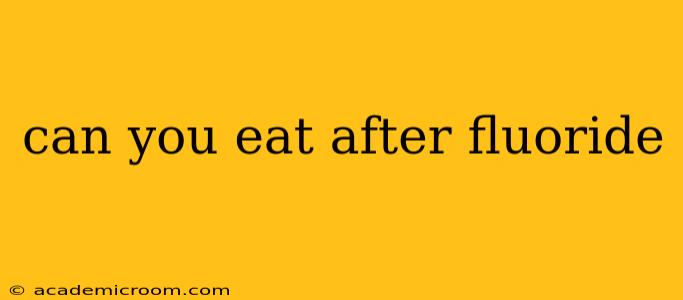Can You Eat After Fluoride Treatment?
The simple answer is yes, you can generally eat after a fluoride treatment, but there are important considerations depending on the type of fluoride treatment you've received. Let's break down the different scenarios and address common concerns.
What are the different types of fluoride treatments?
There are several ways you might receive fluoride, each with slightly different post-treatment recommendations:
- Professional Topical Fluoride Application (in-office): This is a treatment administered by a dentist or hygienist directly onto your teeth. It's often a gel or foam applied for a short period.
- Fluoride Mouthwash (at-home): This is a rinse you use at home to increase fluoride exposure.
- Fluoride Varnish (in-office): This is a thin, protective coating applied to your teeth, typically for children.
- Fluoride Toothpaste (at-home): This is the most common form of fluoride intake, used daily as part of your oral hygiene routine.
How long should I wait to eat after a fluoride treatment?
The waiting period after a fluoride treatment varies depending on the type and concentration of fluoride used. Here's a more detailed breakdown:
Professional Topical Application & Varnish: Generally, it's recommended to wait at least 30 minutes after a professional fluoride treatment (gel, foam, or varnish) before eating or drinking anything other than water. This allows the fluoride to fully absorb into your tooth enamel. Avoid acidic or sugary drinks and foods during this time, as they can interfere with the treatment's effectiveness.
Fluoride Mouthwash: After rinsing with fluoride mouthwash, you can usually eat and drink immediately. However, it's still best to avoid acidic foods and beverages for at least 30 minutes to maximize the fluoride's benefits.
Fluoride Toothpaste: There is no waiting period required after brushing with fluoride toothpaste.
What should I avoid after a fluoride treatment?
Regardless of the type of fluoride treatment, it's generally advisable to avoid these things for at least 30 minutes afterward:
- Acidic foods and drinks: These can erode enamel and reduce the fluoride's effectiveness. Examples include citrus fruits, soda, and tomato-based products.
- Sugary foods and drinks: Sugar provides fuel for bacteria that cause tooth decay. It's best to limit sugar intake throughout the day, but especially after a fluoride treatment.
- Hot beverages: Hot liquids can potentially affect the fluoride's absorption into the enamel, making it less effective.
What if I accidentally eat or drink something after a fluoride treatment?
Don't panic if you accidentally eat or drink something before the recommended waiting period. While it might slightly reduce the treatment's effectiveness, it won't negate it entirely. Good oral hygiene practices, including regular brushing and flossing, remain crucial for maintaining good dental health.
Can fluoride treatments cause any side effects?
Mild side effects such as temporary white spots on teeth or a slightly bitter taste can sometimes occur, especially after professional fluoride treatments. These typically disappear quickly. More serious side effects are rare.
How often should I get fluoride treatments?
The frequency of fluoride treatments depends on your individual needs and risk for cavities. Your dentist can recommend the most appropriate schedule for you, considering factors such as your age, diet, and oral hygiene habits.
Remember to always consult your dentist or dental hygienist for personalized advice regarding fluoride treatments and post-treatment care. They can provide specific recommendations tailored to your individual situation.
